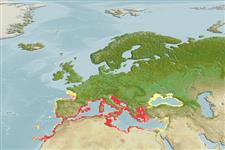>
Eupercaria/misc (Various families in series Eupercaria) >
Sparidae (Porgies)
Etymology: Diplodus: Greek, diploos = twice + Greek, odous = teeth (Ref. 45335).
More on author: Linnaeus.
Environment: milieu / climate zone / depth range / distribution range
Ecologie
marien; brak water benthopelagisch; diepte 0 - 90 m (Ref. 4781). Subtropical; 49°N - 27°N, 19°W - 42°E
Eastern Atlantic: Canary islands, also found along the coast of Portugal northward to the Bay of Biscay, Mediterranean, Black Sea and Sea of Azov (Ref. 4781).
Lengte bij maturiteit / Grootte / Gewicht / Leeftijd
Maturity: Lm 11.6, range 8 - 19.6 cm
Max length : 28.0 cm TL mannelijk / geslacht onbekend; (Ref. 124816); common length : 13.0 cm TL mannelijk / geslacht onbekend; (Ref. 3397); max. gepubliceerd gewicht: 330.00 g (Ref. 115876); max. gerapporteerde leeftijd: 17 Jaren (Ref. 124518)
Korte beschrijving
Determinatiesleutels | Morfologie | Morfometrie
Dorsale stekels (totaal) : 11; Dorsale zachte stralen (totaal) : 11 - 13; Anale stekels: 3; Anale zachte stralen: 11 - 12.
Inhabit chiefly Zostera seagrass beds but also found on Posidonia beds and sandy bottoms, rarely on rocky bottoms. Carnivorous, feed on worms, crustaceans, mollusks, echinoderms and hydrozoans. The sexes are separated, although these fish are potential hermaphrodites; certain individuals are protandric (Ref. 4781).
Normally sexes are separate but some individuals are protandrous due to geographical variation in sexual pattern (Ref. 103751). However, histological studies confirm no degenerating functional tissue of one sex (e.g. vitellogenic or later-stage follicles) and no proliferation of tissue of the other sex can be found on this species indicating the absence of sex change. This particular condition is also known as nonfunctional hermaphroditism previously known as rudimentary hermaphroditism (Ref. 91314). Also Ref. 28504.
Bauchot, M.-L. and J.-C. Hureau, 1990. Sparidae. p. 790-812. In J.C. Quero, J.C. Hureau, C. Karrer, A. Post and L. Saldanha (eds.) Check-list of the fishes of the eastern tropical Atlantic (CLOFETA). JNICT, Lisbon; SEI, Paris; and UNESCO, Paris. Vol. 2. (Ref. 3688)
Status op de Rode Lijst van het IUCN (Ref. 130435)
Gevaar voor de mens
Harmless
Gebruik door de mens
Visserij: commercieel; sportvis: ja
Tools
Speciale rapporten
Download XML
Internetbronnen
Estimates based on models
Preferred temperature (Ref.
123201): 14.8 - 21.1, mean 18.3 °C (based on 220 cells).
Fylogenetische diversiteitsindex (Ref.
82804): PD
50 = 0.5000 [Uniqueness, from 0.5 = low to 2.0 = high].
Bayesian length-weight: a=0.01202 (0.01093 - 0.01323), b=3.07 (3.05 - 3.09), in cm total length, based on LWR estimates for this species (Ref.
93245).
Trofisch niveau (Ref.
69278): 3.6 ±0.0 se; based on diet studies.
Generation time: 4.5 (2.4 - 6.4) years. Estimated as median ln(3)/K based on 18
growth studies.
Weerstandsvermogen (Ref.
120179): Gemiddeld, minimale populatieverdubbelingstijd 1,4-4,4 jaar (K=0.2-0.5; tmax=7; Fecundity=18,000 - 212,000).
Prior r = 0.54, 95% CL = 0.35 - 0.80, Based on 3 full stock assessments.
Fishing Vulnerability (Ref.
59153): Moderate vulnerability (36 of 100).
Climate Vulnerability (Ref.
125649): Moderate vulnerability (36 of 100).
Nutrients (Ref.
124155): Calcium = 83.2 [48.2, 160.3] mg/100g; Iron = 0.984 [0.561, 1.738] mg/100g; Protein = 19.3 [18.4, 20.3] %; Omega3 = 0.427 [0.224, 0.818] g/100g; Selenium = 23.7 [11.6, 43.4] μg/100g; VitaminA = 20.1 [6.8, 55.9] μg/100g; Zinc = 1.06 [0.72, 1.48] mg/100g (wet weight);
